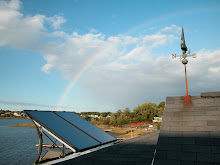There has been a lot of recent interest in weather responsive controls for residential heating systems. This is nothing new. I have been installing them since the early 1990's. Basically, it is a control that connects to your heating plant and provides additional control of your system temperature. A weather responsive control has at least two sensors, one to measure outdoor temperature and one to measure your system temperature. More complex controls can have additional sensors for heating zones, individual rooms and domestic hot water.
Your heating system was installed based on what is known as design temperature, or the coldest expected temperature for your area. Heating systems could be considered oversized, since the temperature may only fall that low for a few days of the year, but when it does, your house will stay warm. Also, your heating plant operates like a teenager with a Mustang, either petal to the metal, or slam on the brakes. When there is a call for heat, your heating plant fires and runs up to it's highest setting. When your thermostat is satisfied, it shuts off. This is perfect, if it is the dead of winter and you are at the design temperature, but how often is that? If it isn't that cold out, it makes sense that you don't need as much heat from your system, right?
A weather responsive control does just that. It modulates your system temperature based on the outdoor temperature. When it isn't that cold out it doesn't let your system get too hot. It only lets your system reach a temperature sufficient to heat your home at the current outdoor temperature. A weather responsive control will work with any type of heating system, but it will work best with radiant floors, cast iron radiators, or radiant baseboard.
It looks like Junior just traded in the sports car for a hybrid!
Subscribe to:
Post Comments (Atom)

No comments:
Post a Comment